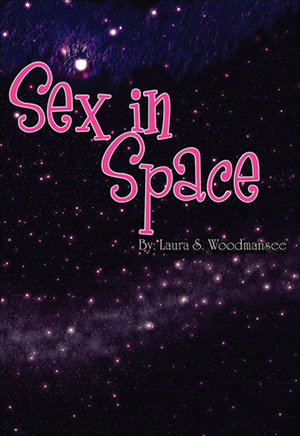Category: Non-Fiction
Reviewed by: Susan Raizer
Title: Sex in Space
Author: Laura Woodmansee
NSS Amazon link for this book
Format: Paperback
Pages: 136
Publisher: C.G Publishing Inc.
Date: August, 2006
Retail Price: $17.95
ISBN: 1894959442
The title of the book, Sex in Space, conjures up exotic activities in an otherworldly medium. Laura Woodmansee, also the author of Women Astronauts and Women of Space: Cool Careers on the Final Frontier, has written a book that explores many of our questions about this delicate topic.
While the book is replete with numerous personal interviews with people involved in manned space programs, the reader is left with the feeling that we will never know what really occurred in the far-off reaches of space. The book contains numerous photographs of space travelers, primarily USSR (and later Russian) and Americans, as well as other photographs cogent to the particular chapter. Ms. Woodmansee provides scenarios that we have all speculated about, sexual activities of the early space cosmonauts and astronauts on coed missions or long duration same-sex missions. The author speculated a great deal as she was unable to obtain concrete evidence that anything occurred between participants on space missions. No one was forthcoming as their careers would have been over if they admitted to such activities.
Most of the book is spent in a discussion of space as a new frontier in tourism, a reality that will exist in the not-so-distant future, as the Russians have accommodated several space tourists to date on the International Space Station. There will be spaceships and even hotels in space that will present a whole new range of activities that will have to be learned, from simple chores to more complex ones that involve controlled movements in a weightless environment. It is interesting to note that astronauts on various types of space craft have performed tests to determine how long and how well they adapt to a zero-gravity environment. The results from these tests will be used by future spacecraft planners and those developing and constructing craft for the tourist industry.
As many astronauts have found, acclimating oneself to weightlessness very often brings on a sickness akin to motion sickness that might last for several days. Once conditioned, the tourists will then be able to pursue more sophisticated activities, including sex. The conditioning will take a lot of practice as was found by a participant on a hyperbolic flight who tried to embrace a fellow traveler only to rebound! Through the use of small crash dummies, the author demonstrated different positions that might be experimented with. The major difficulty in a weightless environment is the need to anchor the partners or they will float in opposite directions. Once the mechanics are learned, experimentation will provide a unique experience. While the use of the crash dummies was successful in the visualization of these activities, they are not appropriate for viewing by minors.
From enjoying intimate activities in space, the author goes into a discussion of the physiological effects that space might have on participants, primarily if conception has occurred. From experiments on animals and other species, namely insects and frogs, most test results were not favorable towards normal births in space. As reported by the author, conception did occur for these species within a controlled environment on a space ship, with various outcomes: the offspring failed to develop normally, did not survive, or survived for only a short period once returned to Earth. The results failed to produce a consensus and will lead to more testing before allowing testing on humans.
The effects of weightlessness and radiation in space on the human skeletal system, musculature, including the heart, nervous system and circulation system has only been observed from manned missions. Astronauts report that reproductive systems are disrupted while in space. While short-duration missions like the Shuttle do not cause permanent damage, long missions (Mir or the ISS) have a more lasting effect, one that has not yet been fully documented. Without testing on humans, the author has speculated on the fact that human conception might not be possible because weightlessness may cause eggs to miscarry or prevent them from firmly taking root in the mother’s uterus. In addition, it is not known what effect radiation might have on the fertilized embryo and how this might affect cell division. Conversely, we do not know if contraceptives will be effective, although there have been studies of drug use on astronauts in space, with the findings inconclusive. Nevertheless, it is likely that a child conceived in the weightless environment of space might be born successfully, but altered in such a way that he or she might never be able to journey to the planet of its parents. Much more study is necessary.
The book was an interesting study in the possibilities that have not been documented as yet, but contained too many ‘what ifs’ to make it a plausible study of human personal activities in space. The title of the book provided an anticipation of concrete evidence that was not forthcoming, leaving this reader somewhat frustrated. Nevertheless, Sex in Space offers a good introduction to this sensitive topic and a good starting point for future space tourists and planners.
© 2006 Susan Raizer
Please use the NSS Amazon Link for all your book and other purchases. It helps NSS and does not cost you a cent! Bookmark this link for ALL your Amazon shopping!



















